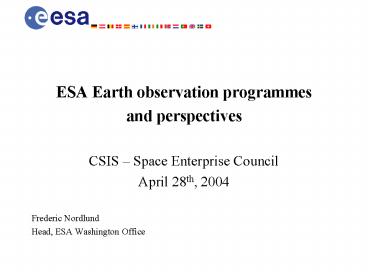ESA Earth observation programmes - PowerPoint PPT Presentation
1 / 8
Title:
ESA Earth observation programmes
Description:
... areas: launchers, space science, Earth observation, human space flight, ... on existing initiatives (47 nations and the EC at the Tokyo Summit this week) ... – PowerPoint PPT presentation
Number of Views:69
Avg rating:3.0/5.0
Title: ESA Earth observation programmes
1
- ESA Earth observation programmes
- and perspectives
- CSIS Space Enterprise Council
- April 28th, 2004
- Frederic Nordlund
- Head, ESA Washington Office
2
The European Space Agency (ESA) in brief
- ESA - an international inter-governmental agency
- ESA has 15 Member States Austria, Belgium,
Denmark, Finland, France, Germany, Ireland,
Italy, Norway, the Netherlands, Portugal, Spain,
Sweden, Switzerland and the United Kingdom - Canada takes part in some projects under a
cooperation agreement - Programmatic areas launchers, space science,
Earth observation, human space flight,
microgravity research, navigation,
telecommunications, etc. - Budget for 2004 2.7 billion euros
- Staff 1920
3
ERS
ENVISAT
4
METOP
Meteosat Second Generation
5
Cryosat (2004)
Soil Moisture and Ocean Salinity (2007)
Atmospheric Dynamics Mission - Aeolus (2007)
Gravity and Ocean Circulation Explorer (2006)
6
Global Monitoring for Environment and Security
(GMES)
- Joint ESA European Commission initiative
- A programme to provide information to
decision-makers and support EU policies - Completion of GMES initial period (2001 2003)
- GMES implementation phase (2004-2008)
- Four major components
- Space remote sensing
- In-situ and airborne observations
- Data integration and information management
- Services
7
- The Earth Observation Summit on 31 July 2003
initiated a comprehensive, coordinated, and
sustained Earth observation system or systems
among governments and the international community
to understand and address global environmental
and economic challenges - Current preparations of a 10-year implementation
plan for coordinated Earth observation systems
building on existing initiatives (47 nations and
the EC at the Tokyo Summit this week) - Adoption of the 10-year plan during a Summit in
Europe in February 2005
8
- Necessary balance between non-discriminatory
access, economic viability and incentives for
private service providers - Service providers in Europe are a mix of small
and medium companies as well as satellite
operators investing more and more in services and
value-added chain. - ESA data policy differentiate scientific use
(category I) and commercial use (category II). - EMMA and SARCOM consortia were contracted out 4
years ago for category II - Current reflections about a data policy
evolution in the context of new systems and GMES































